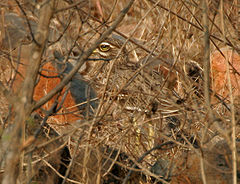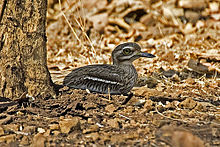- Eurasian Stone-curlew
-
For the group of birds known as thick-knees or stone-curlews (of which this species is a member), see stone-curlew.
Stone Curlew 
Stone Curlew Conservation status Scientific classification Kingdom: Animalia Phylum: Chordata Class: Aves Order: Charadriiformes Family: Burhinidae Genus: Burhinus Species: B. oedicnemus Binomial name Burhinus oedicnemus
(Linnaeus, 1758)The Stone Curlew, Eurasian Thick-knee, or Eurasian Stone-curlew Burhinus oedicnemus is a northern species of the Burhinidae (stone-curlew) bird family.
It is a fairly large wader though is mid-sized by the standards of its family. Length ranges from 38 to 46 cm (15 to 18 in), wingspan from 76 to 88 cm (30 to 35 in) and weight from 290 to 535 g (10 to 18.9 oz).[2][3] with a strong yellow and black beak, large yellow eyes (which give it a "reptilian", or "goggle-eyed" appearance), and cryptic plumage. The bird is striking in flight, with black and white wing markings.
Despite being classed as a wader, this species prefers dry open habitats with some bare ground. It is largely nocturnal, particularly when singing its loud wailing songs, which are reminiscent of that of curlews. Food consists of insects and other small invertebrates. It will also take small reptiles and rodents. It lays 2-3 eggs in a narrow scrape in the ground.
The stone curlew occurs throughout Europe, north Africa and southwestern Asia. It is a summer migrant in the more temperate European and Asian parts of its range, wintering in Africa.
Contents
Etymology
The genus name Burhinus comes from the Greek bous, ox, and rhis, nose.[4] The species name oedicnemus comes from the Greek oidio, to swell, and kneme, the shin or leg, referring to the bird's prominent tibiotarsal joints[4] which also give it the common name of "thick-knee". This is an abbreviated form of Pennant's 1776 coinage "thick kneed bustard".[5]
The name "Stone Curlew" was first recorded in 1667. It derives from the bird's nocturnal calls sounding like the unrelated Eurasian Curlew Numenius arquata and its preference for barren stoney heaths.[5]
Subspecies
There are six subspecies of Burhinus oedicnemus:[6]
 Camouflaged Stone-curlew in Hyderabad, India
Camouflaged Stone-curlew in Hyderabad, India
- Burhinus oedicnemus distinctus (Bannerman, 1914) Canary Islands central and western [7]
- Burhinus oedicnemus harterti Vaurie, 1963
- Burhinus oedicnemus indicus (Salvadori, 1865)
- Burhinus oedicnemus insularum (Sassi, 1908) Canary Islands, eastern [8]
- Burhinus oedicnemus oedicnemus (Linnaeus, 1758)
- Burhinus oedicnemus saharae (Reichenow, 1894)
References
- ^ BirdLife International (2004). Burhinus oedicnemus. 2006. IUCN Red List of Threatened Species. IUCN 2006. www.iucnredlist.org. Retrieved on 11 May 2006. Database entry includes justification for why this species is of least concern
- ^ [1] (2011).
- ^ CRC Handbook of Avian Body Masses by John B. Dunning Jr. (Editor). CRC Press (1992), ISBN 978-0849342585.
- ^ a b Jobling, James A (1991). A Dictionary of Scientific Bird Names. OUP. ISBN 0 19 854634 3.
- ^ a b Lockwood, W B (1993). The Oxford Dictionary of British Bird Names. OUP. ISBN 978-0198661962.
- ^ título = Birds of the World -- current valid scientific avian names.
- ^ Datos recientes sobre el Alcaraván (Burhinus oedicnemus L. 1758) en la Isla de La Palma (Canarias): notas Recent data on the Stone Curlew (Burhinus oedicnemus) on La Palma (Canary Islands): notes Autores: Rubén Barone Tosco, Felipe Siverio, D. Trujillo Localización: Vieraea: Folia scientarum biologicarum canariensium, ISSN 0210-945X, Nº. 21, 1992 , pag. [168 http://dialnet.unirioja.es/servlet/articulo?codigo=2358445]
- ^ Datos recientes sobre el Alcaraván (Burhinus oedicnemus L. 1758) en la Isla de La Palma (Canarias): notas Recent data on the Stone Curlew (Burhinus oedicnemus) on La Palma (Canary Islands): notes Autores: Rubén Barone Tosco, Felipe Siverio, D. Trujillo Localización: Vieraea: Folia scientarum biologicarum canariensium, ISSN 0210-945X, Nº. 21, 1992 , pag. 168
External links
- ARKive Photos, video.
- Identification guide (PDF) by Javier Blasco-Zumeta
Categories:- IUCN Red List least concern species
- Burhinus
- Birds of Africa
- Birds of Asia
- Birds of Europe
Wikimedia Foundation. 2010.


